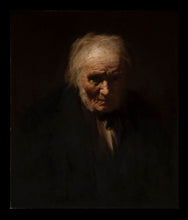James Irvine, R.S.A. (1833–1889) - Portrait of Seaman James Coull (1786-1880)
Adding product to your cart
Oil on canvas. Contained in original giltwood frame, labelled verso ‘A Trafalgar Hero.’
The subject of this striking portrait had a long and eventful life. Before his death in Montrose aged over ninety, James Coull (1786-1880) claimed to have fought at the battle of Trafalgar and to have steered H.M.S. Shannon into her famous engagement with the U.S.S. Chesapeake in 1813. Wounded in the left wrist by a musket ball early in that action, he joined the boarding party which captured the American frigate, suffering a further head injury during the close quarter fighting.
According to his own account, Coull was pressed into the Royal Navy from the Montrose fishing fleet, and successively served in H.M.S. Centaur and H.M.S. Acteon before joining the 38-gun frigate Shannon as a petty officer. After the action his hand was amputated forcing him to retire from the Royal Navy on a pension of £16 per annum. He returned to sea as a cook in the Montrose based Arctic whaling fleet, and crossed the Atlantic some fourteen times before his final retirement.
Read more
In old age Coull became widely celebrated, his fame enhanced by his obvious talent for story telling and by a series of striking portraits of him by Scottish artist James Irvine. Both the London and New York Times published an obituary following Coull’s death in 1880 when he was buried in Montrose with full military honours. His coffin was draped in the Union Jack and borne by sailors to the grave over which a salute was fired, while all the ships then in harbour lowered their colours to mark the passing of a naval hero.
Born at Menmuir in Angus, James Irvine (1833–1889) is recognised as one of the finest portrait-painters of Victorian Scotland. Based in Edinburgh but frequently working in Arbroath and Montrose, Irvine built his reputation painting, principally, the great Scottish men of his day among them Dr Joseph Bell (1837-1911), the inspiration for Arthur Conan Doyle’s fictional detective Sherlock Holmes. Irvine’s best work is distinguished by the use of dramatic lighting, dark backgrounds and rough, easy brushstrokes: all characteristics which recall the paintings of Rembrandt. His most striking and sympathetic portraits were of Montrose residents Louis Black (circa 1820-1886) who was a freed slave, and of James Coull. Undoubtedly, the artist was drawn to these men by their extraordinary personal histories, their celebrity and by their memorable and affecting looks.
Irvine’s portrait of Coull was a popular success and he may have returned to the subject up to five times. His Coull, Quartermaster, one of the boarders of the Chesapeake was exhibited at the Royal Scottish Academy in 1874; and James Coul Seaman of the Shannon in her celebrated action with the Chesapeake 1st June 1813 at the 1891 Royal Naval Exhibition in Chelsea.
None of these works were traced until 2008 when one of Irvine’s lost portraits of Coull was purchased and exhibited by the Scottish National Portrait Gallery, Edinburgh. The re-discovery of this second example offers another rare and vivid image of a common seaman from Nelson’s day.






